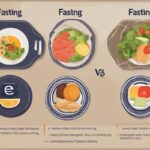Hey there, health enthusiasts! If you’ve been searching for a practical and sustainable way to improve your wellness, lose weight, or simply reset your relationship with food, you’ve likely stumbled across intermittent fasting. As a popular approach in the fasting world, the 5:2 Diet has captured attention for its flexibility and promising results. In this ultimate fasting guide, we’re diving deep into what the 5:2 Diet is, how it works, and why it might just be the game-changer you’ve been looking for. Whether you’re a newbie to fasting methods or a seasoned pro, stick with me as we explore the science, benefits, and practical tips to make this diet work for you.
What Is the 5:2 Diet? A Beginner’s Fasting Guide
Let’s start with the basics. The 5:2 Diet, often referred to as a type of intermittent fasting, is a dietary approach where you eat normally for five days of the week and significantly reduce your calorie intake on the remaining two days. On those “fasting” days, women typically aim for about 500 calories, while men target around 600 calories. This isn’t about starvation—it’s about controlled restriction to give your body a break from constant digestion and tap into some incredible health benefits. Unlike other fasting plans, the 5:2 Diet doesn’t dictate what you eat on non-fasting days, though a balanced, nutrient-rich diet is encouraged for the best results.
Developed by Dr. Michael Mosley, a British physician and journalist, this method gained popularity through his book, The Fast Diet, co-authored with Mimi Spencer. It’s often praised for its simplicity and adaptability, fitting into busy lifestyles without the rigidity of daily calorie counting. If you’re new to fasting strategies, the 5:2 diet can be an approachable entry point to understanding how intermittent fasting impacts your body.
The Science Behind the 5:2 Diet: Why It Works
Now, you might be wondering, “Why restrict calories only two days a week? What’s the magic behind this fasting guide?” The answer lies in how our bodies respond to periodic calorie reduction. Research suggests that intermittent fasting, like the 5:2 method, can trigger a range of physiological benefits, from improved insulin sensitivity to cellular repair processes. For instance, fasting periods may lower blood sugar levels and reduce insulin resistance, which is a key factor in managing or preventing type 2 diabetes (Barnard et al., 2019).
Moreover, fasting can promote autophagy, a process where your cells “clean house” by removing damaged components, potentially reducing inflammation and supporting longevity (Mattson et al., 2017). Studies also indicate that intermittent fasting may aid in weight loss by reducing overall calorie intake and boosting metabolism through shifts in hormone levels, like increased norepinephrine (Tinsley & La Bounty, 2015). While the 5:2 Diet isn’t a one-size-fits-all solution, the science behind fasting benefits shows it’s more than just a fad—it’s a method grounded in biology.
Health Benefits of the 5:2 Diet: What to Expect
Beyond the science, let’s talk about the tangible perks of following this fasting routine. People who adopt the 5:2 Diet often report a variety of health improvements, and research backs up many of these claims. Here are some of the standout benefits you might experience:
- Weight Loss: By creating a calorie deficit over the week, the 5:2 Diet can help shed pounds without the constant restriction of traditional diets (Harvie et al., 2011).
- Improved Metabolic Health: Fasting days may lower blood pressure, cholesterol levels, and markers of inflammation, supporting heart health (Varady et al., 2013).
- Better Brain Function: Some studies suggest intermittent fasting could enhance cognitive clarity and protect against neurodegenerative diseases (Mattson et al., 2017).
- Increased Energy: Many followers report feeling more alert and energetic, likely due to stabilized blood sugar levels on non-fasting days.
Of course, results vary from person to person, but these potential fasting advantages make the 5:2 Diet an appealing choice for those looking to prioritize health without overhauling their entire lifestyle.
How to Get Started with the 5:2 Diet: Practical Tips
Ready to give this fasting guide a try? Starting the 5:2 Diet doesn’t have to be complicated, but a little planning goes a long way. First, choose your two fasting days—ideally non-consecutive, like Monday and Thursday, to avoid feeling overly deprived. On those days, focus on low-calorie, high-volume foods like vegetables, lean proteins, and broths to keep hunger at bay. On the other five days, eat as you normally would, but aim for balance to maximize the diet’s effectiveness.
Here are some actionable tips to ease into this intermittent fasting plan and set yourself up for success:
- Stay Hydrated: Drink plenty of water, herbal tea, or black coffee on fasting days to curb cravings and support your body’s detox processes.
- Plan Your Meals: Prep small, nutrient-dense meals for fasting days to avoid impulsive eating or going over your calorie limit.
- Listen to Your Body: If you feel dizzy or overly fatigued, consider adjusting your calorie intake or consulting a healthcare provider.
- Start Slow: If 500–600 calories feel too restrictive at first, ease in by reducing gradually over a few weeks.
- Track Progress: Use a journal or app to monitor your meals, mood, and energy levels to see how the diet affects you.
Remember, the 5:2 Diet is about flexibility. If a fasting day doesn’t work with your schedule, shift it to another day. The goal is consistency, not perfection, as you navigate this fasting journey.
Potential Challenges and How to Overcome Them
Let’s be real—fasting, even just two days a week, isn’t always a walk in the park. Some common hurdles include hunger pangs, irritability, or social situations that make fasting tricky. On fasting days, your body might protest initially as it adjusts to fewer calories, and you might find yourself daydreaming about pizza. But don’t worry; these challenges are manageable with the right mindset and strategies.
Distraction is key—keep busy with work, light exercise, or hobbies to take your mind off food. If social events fall on fasting days, plan ahead by sipping water or tea to stay full, or reschedule your fasting day if needed. Research also shows that hunger tends to decrease over time as your body adapts to intermittent fasting (Johnstone, 2015). Patience and preparation are your best allies as you master this fasting approach.
Who Should Try the 5:2 Diet—and Who Shouldn’t
While the 5:2 Diet offers a flexible entry into fasting techniques, it’s not for everyone. If you’re generally healthy and looking to lose weight or boost metabolic health, this could be a great fit. However, certain groups should approach fasting with caution or avoid it altogether. Pregnant or breastfeeding women, individuals with eating disorders, and those with medical conditions like diabetes or low blood pressure should consult a doctor before starting (Harvard Medical School, 2020).
It’s also worth noting that fasting isn’t a quick fix. Sustainable results come from pairing the 5:2 Diet with mindful eating and regular physical activity. If you’re unsure whether this fasting method aligns with your health goals, a chat with a nutritionist can provide personalized guidance.
As we wrap up this fasting guide, I hope you feel equipped to explore the 5:2 Diet with confidence. It’s not just about cutting calories—it’s about giving your body a chance to reset, heal, and thrive through strategic fasting practices. Whether your goal is weight loss, better energy, or improved health markers, this approach offers a balanced way to achieve it without feeling deprived. Start small, stay consistent, and remember that every step forward is progress. Have you tried the 5:2 Diet or another fasting regimen? Drop your thoughts or questions below—I’d love to hear your story!
References
- Barnard, N. D., Levin, S. M., & Yokoyama, Y. (2019). A systematic review and meta-analysis of changes in body weight in clinical trials of vegetarian diets. Journal of the Academy of Nutrition and Dietetics, 119(2), 291-302. https://doi.org/10.1016/j.jand.2018.11.016
- Harvie, M. N., Pegington, M., Mattson, M. P., et al. (2011). The effects of intermittent or continuous energy restriction on weight loss and metabolic disease risk markers: A randomized trial in young overweight women. International Journal of Obesity, 35(5), 714-727. https://doi.org/10.1038/ijo.2010.171
- Johnstone, A. (2015). Fasting for weight loss: An effective strategy or latest dieting trend? International Journal of Obesity, 39(5), 727-733. https://doi.org/10.1038/ijo.2014.214
- Mattson, M. P., Longo, V. D., & Harvie, M. (2017). Impact of intermittent fasting on health and disease processes. Ageing Research Reviews, 39, 46-58. https://doi.org/10.1016/j.arr.2016.10.005
- Tinsley, G. M., & La Bounty, P. M. (2015). Effects of intermittent fasting on body composition and clinical health markers in humans. Nutrition Reviews, 73(10), 661-674. https://doi.org/10.1093/nutrit/nuv041
- Varady, K. A., Bhutani, S., Klempel, M. C., et al. (2013). Alternate day fasting for weight loss in normal weight and overweight subjects: A randomized controlled trial. Nutrition Journal, 12, 146. https://doi.org/10.1186/1475-2891-12-146






